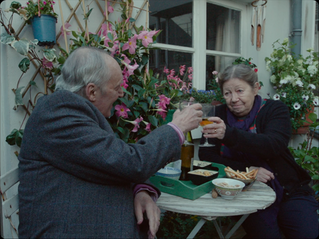Palo Alto
- Rebecca Rosén
- Feb 13, 2022
- 3 min read
Gia Coppola, 2013

A thrown strawberry milkshake against rough asphalt; its sweet pink liquid seeping into the cracks. This shot, from Gia Coppola’s suburban dream Palo Alto, introduces viewers to what the film is fundamentally interested in: the presence of something brutal beneath something tender. While other, similar images appear throughout the film, there’s one shot that distinguishes itself from the cluster.
The haunting shot is from a minute-long sequence focusing on Emily, played by Zoe Levin, a young girl who spends most of her time yearning for someone to care for her. This search for love has resulted in her offering up sexual favours, in the hope that someone stays around after the act is finished. However, with a reputation that precedes her, some of her male classmates use this to their advantage. To them, she exists only as an object.
Before the aforementioned sequence reaches its disturbing culmination, Coppola carefully includes details that emphasise Emily’s innocence, depicted in the shot selected. Initially, we see a happy Emily wearing colourful rubber bracelets, swinging on a swing and cartwheeling. These all act as reminders that, while she’s engaging in adult behaviour (alcohol and sex), she’s still far from being an experienced adult.
Inevitably, playful shots turn sour. We see a close-up of her face, her joyful exterior has changed into something sadder, more lonesome. On its own, the shot establishes a connection between character and audience. Without any verbal communication, this single shot, one notably filmed at eye-level, accentuates Emily's state of mind. It forces the viewer to be there, with her, in the moment; to feel what she feels, even if only temporarily.
This close-up is then accompanied by narration, detailing her experience of sexual assault. Indeed, while this shot of Emily may look ordinary in passing, with context, one barely dares to meet her piercing eyes. Emily's facial expression, besides establishing an intimate connection with the viewer, evokes feelings of guilt. Her condemnatory and disappointing eyes meet ours. Is she judging her abuser, whom the camera is a stand-in for? Or us, the viewers, for simply letting these things happen in the first place?
It is well known that, in film, there is a history of eagerness to objectify and sexualise girls and women, even during scenes of sexual violence. Coppola’s decision to not exploit Emily elevates the cinematic material, this gaze proves to be more startling than something more explicit. As Emily looks straight into the camera, there’s a real sense of intimacy established, as if viewers are offered a secret - one of Emily's inner feelings about her assault - before anyone else.
Throughout the film, Fred, her abuser, is portrayed as impulsive; the underlying proposition is that it’s only a matter of time before he eventually goes too far. In crossing this line, he supplants an appealing dream with ugly reality. The sense of unease is only heightened by Fred’s narration; he calmly talks through his version of the events with seemingly no regret, only a self-conviction that he and his friends did nothing wrong. Emily's feelings clearly differ from this and so, through this shot, she's able to convey them without being reduced to flesh for others - characters, the camera and the viewer - to hungrily savour.
Composing dreamy shots of Emily to the score of Fred’s harrowing narration masterfully creates an extreme and immediate contradiction for viewers to decipher. It's a reminder that often what unsettles us is not necessarily visually horrifying, but hidden beneath a charming surface - it’s right in front of us, hiding in plain sight and seamlessly blending into the crowd.








Comments